Pipe stress analysis is a critical part of piping design, As any failure in the piping system can cause to the unpredictable results. Piping stress analysis is a combination of art and science.
Stress engineers should have a good understanding of piping layouts, ASME code requirements, and the art of optimization. The parameters like safety of pipe, equipment, nozzle, piping fittings, and piping components are addressed in the pipe stress analysis.
Piping Stress analysis involves examining the flexibility and stiffness of a stress critical piping system under different loading conditions. Piping stress analysis determines the maximum stresses, displacements, forces, and moments at restraints. And it suggests necessary modifications for satisfying the ASME Code requirements for limits of sustained, displacement & occasional load allowable stresses.
Table of Contents
What Causes Stress in the Pipe?
- Live and dead load (weight of Pipe, piping component, insulation, flowing fluid, etc)
- Line pressure
- Restriction to pipe expansion and contraction
- Discharge reaction (for example Relief valve, PSV, etc.
- Occasional load like wind/seismic load
- Dynamic load of fluid flowing
When to do Pipe Stress Analysis?
There are numbers of “thumb rule” for when to apply pipe stress analysis. Different industries or companies may use strict or simple guidelines for performing piping stress analysis. I have summarized a few of them-
- If the system operating temperature exceeds 150F and the pipe or line size is 4″ or above
- If the system temperature exceeds 300F, we should analyze lines smaller than 4″ also
- If any line size is above 12″ (some say 8″), as “bigger the pipe size heavier the weight”
- If the line size is 2 ½” and above, connected to rotating equipment
- If the line size is 6″ and above, connected to pressure vessels
- If the system is cryogenic
- If the line carries hazardous chemicals
- If the short hot runs of pipe anchored at both ends
- If the professional review or report shows the system to lack the flexibility
- If the piping system is complex means the number of branches is higher.
- If the line belongs suction or discharge, as these lines come under vibration.
- If the plant location is in a high seismic zone.
When Pipe Stress Analysis may NOT be Required?
Sometime we may not be required to do pipe stress analysis, even if the line is stress critical line. But, we should avoid these practices, If the time and cost permits. These are the points to consider for making the decision of not doing stress analysis of some lines-
- If the same type of project or lines has been previously analyzed, then we can compare it with that line. A comparison must be done by an experienced professional.
- If there is no thermal growth in the piping system and the line is smaller.
Why to Perform Pipe Stress Analysis?
- To ensure that piping is routed and supported in a manner that no damage occurs to either the pipe or connected equipment due to the effects of thermal expansion/contraction, or the loads resulting from weight, pressure, wind earthquake, shock, foundation settlement, etc.
- To keep stresses in the pipe and fittings within the code allowable stress limit
- To keep nozzle loading on attached equipment within the allowable limit by manufacturers or standards like (API 610, API 617, the Hydraulic Institute, etc.)
- To keep pressure vessel stresses at piping connections within the ASME Section VIII allowable limit
- To calculate the design loads for the sizing of supports and restraints
- To determine piping displacements for interference checks
- To help for optimization of the piping design
- To avoid excessive piping vibration
- To limit the load on the supporting structure and on the flanged joints
Types of Loads which Creates Stress in the Piping System
Piping systems experience different types of loads, categories into three basic types –
1. Primary/Sustained Load
These mainly consist of internal pressure and dead-weight. Deadweight is from the weight of pipes, fittings, components such as valves, flowing fluid or testing fluid, insulation, aluminum cladding, rubber lining, etc.
A pipe’s and the component’s deadweight causes it to bend (generally downward) between supports and nozzles. It produces axial stresses in the pipe wall (also-called bending stresses) which vary linearly across the pipe cross-section.
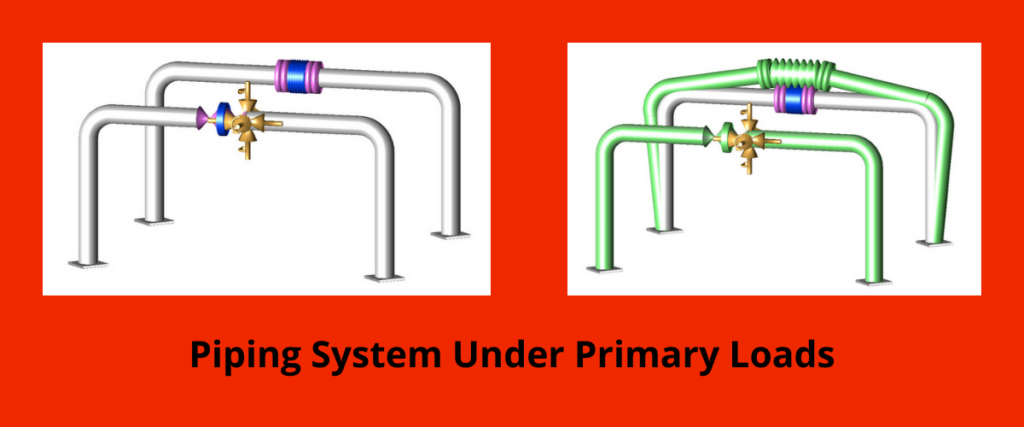
2. Secondary/Thermal Loads
These refer to the cyclic thermal expansion or contraction of the piping system. As it goes from one thermal state to another (example: from shut- down to operating time and then back to shut-down). If the piping system is not restrained in the thermal expansion/contraction directions. Then, under such a cyclic thermal load, the pipe expands/contracts freely. In this case, no internal forces, moments, resulting stresses, and strains are generated in the piping system.
If, on the other hand, the pipe is restrained/Stopped in the directions. It tries to thermally deform (such as at equipment nozzles and pipe supports). Such a constraint on free thermal deformation generates cyclic thermal stresses and strains throughout the system. So, in order to avoid fatigue failure due to cyclic thermal loads, the piping system should be made flexible and it should not be stiff.
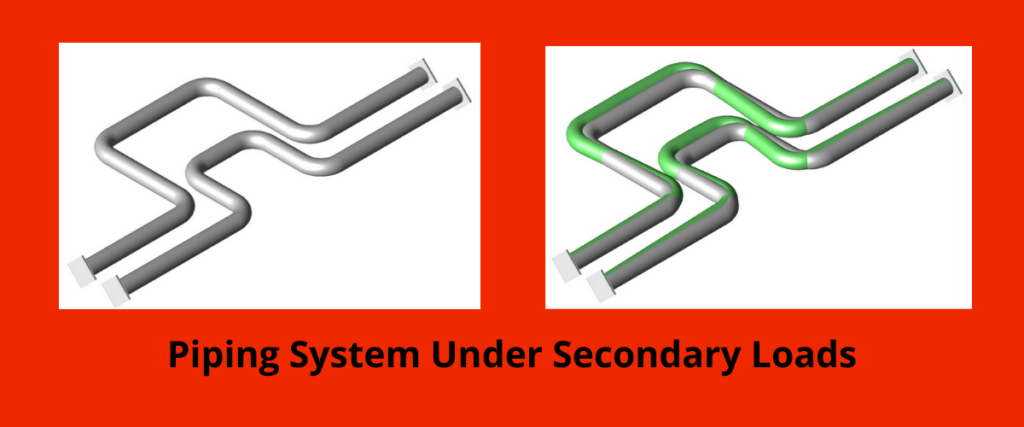
3. Occasional Loads
This type of load acts on the piping systems by occasional events such as earthquakes, wind, or a fluid hammer. To protect piping from wind or earthquake (which normally acts in the horizontal plane), it is required to attach lateral supports instead of axial restraints to the piping system, On the other hand, to protect piping from water/steam hammer loads, both “lateral support and axial restraints may be required.
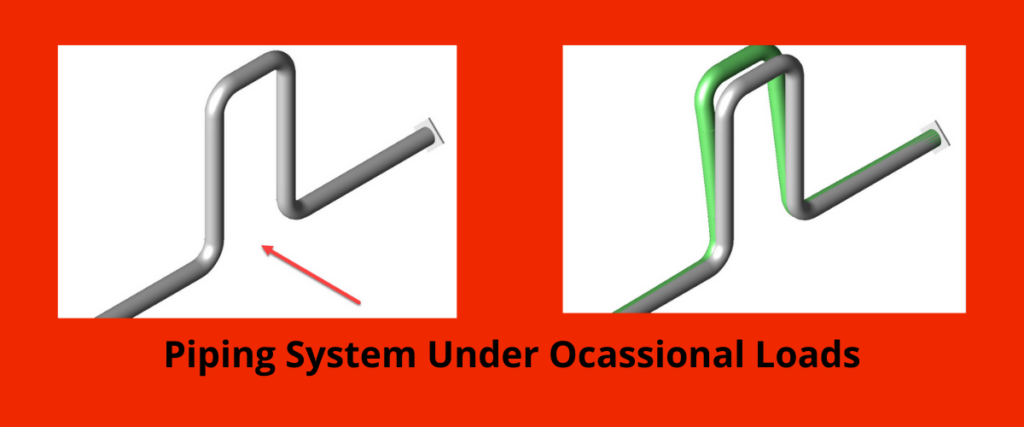
Note: There are mainly two types of stress that occur inside the pipe viz. Axial and Circumferential Stress
Inputs Required for Pipe Stress Analysis
- Line size and Schedule number
- Operating Pressure and Temperature
- Design Pressure and Temperature
- Insulation Type
- Corrosion allowance
- MOC (Material of Construction)
- Specific gravity and density of Fluid Flowing
- Hydro test pressure
- Flange Rating
- Standard valve and flange weight
- Stress Isometric
- Governing Code
- Process Flow Diagram (not mandatory)
- Piping Material Specification
- Equipment and Piping GAD (General Arrangement Drawing)
- Instrument datasheet (if required)
Codes and Standards for Stress Analysis
- ASME B 31.3 – Process Piping
- ASME B 31.1 – Power Piping
- ASME B 31.4 – Hydrocarbon pipeline
- ASME B 31.8 – Gas Pipeline
- ASME B 31.12 – Hydrogen piping and pipeline
- API 610 – Centrifugal Pumps
- API 676 – Positive Displacement Pumps
- API 617 – Centrifugal Compressors:
- API 618 – Reciprocating Compressors:
- ASME Section VIII – Pressure Vessels
Types of Pipe Support
Rigid Support
- Resting
- Anchor
- Guide
- Line stop/Axial stop/Cross guide
- Dummy Leg/Trunion
- Hanger
Flexible Support
- Variable spring support
- Constant spring support
- Snubber
If you want to take your pipe stress analysis knowledge to another level, you can enroll here.
You may also like to read
Different Types of Pipe Support Clamps & Hangers
Checklist For Piping Isometric Drawing
Control Station and Control Valve in the Process Piping

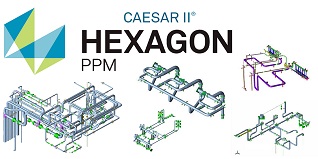

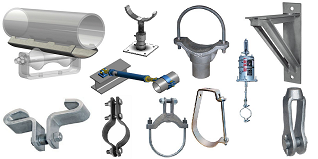
Can you carry out stress analysis for the piping related to turbine, I ll share isometric piping diagram and other details to you. Pls let me know the charges for stress analysis. You can communicate with me via my mail I’d [email protected]
Let me know if you are interested.
Regards
Yunus Shaikh.
My team member will contact you
I am intrested
Very useful presentations many thanks
Thanks for reading
IT WAS REALLY HELPFUL FOR ME.
Congratulations!
Thank you!
Rehan! Its a good presentation. You have covered almost all information pertaining to Piping stress.
Good work.
Thank you so much, Farhan